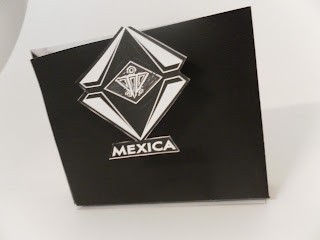Collection of products/ branding include: Promotional posters; t-shirts; t-shirt packaging; business card; letter head.
The repeat pattern on acetate is supposed to mimic a cellophane wrapper for the t-shirt. Seeing as I couldn't print onto the cellophane due to it being too malleable and shiny I thought this was the next best thing that would visually replicate it.
Sticker for the bag that stays stuck once ripped open at the top, serving as a decoration once its function has been fulfilled. Printed black ink on heavy gsm black stock, I then foiled the black in with glossy white foil to give a spot varnish effect. The bright orange ribbon is supposed to inject a hint of colour against the stark monochrome branding, whilst also hinting at the colourful print within.
I have screenprinted my design onto a t-shirt using two colours- red and black. Overall I think it works well, however the only reason this colour scheme has been adopted is because unfortunately, prior to me printing, my screen was not exposed properly, leaving many gaps in my designs. This is how I have overcome it.
The tag at the bottom of the tee adds a sense of quality whilst reinforcing the brands identity.
Below is the proposed stock I initially wanted to print onto, but had to change once I realised it was impossible with the available facilities to me.
Not the best photo, but very hard to take an image that would depict what this is. The lining of the bag. Here I have printed onto acetate and stuck it on the inside of the bag. I wanted to achieve a black ink on black stock finish, but unfortunately with stock this size it is not possible with the available facilities.

















































